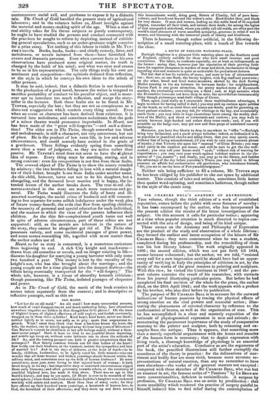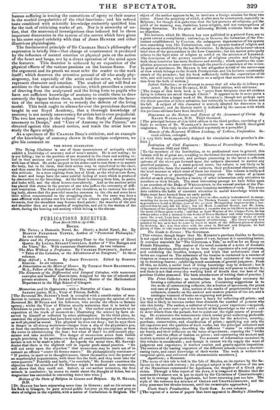SIR CEIARLES BELL'S ANATOMY OF EXPRESSION. THIS volume, though the
third edition of a work of established reputation, comes before the public with some features of novelty: it has been recomposed by the author, who has incorporated in the present edition the results of his latest investigations of the subject. On this account it calls for particular notice ; appearing at a time when popular attention is much directed to topics con- nected with the arts of design, and being of its kind unique.
These essays on the Anatomy and Philosophy of Expression are the product of the study and observation of a whole lifetime : they formed the earliest and latest occupation of the leisure of Sir CHARLES BELL: they were commenced when he was a student, completed during his professorship, and the remodelling of them was his last literary labour. The work originally appeared in 1806; the second edition, which was not put forth till 1824, sooner became exhausted; but the author, we are told, "resisted every call for a new impression until he should have had an oppor- tunity of verifying in Italy the principles of criticism in art, by the study of the works of the great masters in painting and sculpture. With this view, he visited the Continent in 1840 " ; and the pre- sent volume contains the result of his researches, with extracts from his journal illustrating particular points. But before he had completed his final revision of the whole for the press, the author died, on the 29th April 1842; and the work appears with a preface by his brother, who also died before its publication. The purpose of Sir CHARLES BELL 18 to account for the outward indications of human passions by tracing the physical effects of strong emotion on the vital powers and muscular action ; illus- trating the phaenornena of external character by reference to the conformation of brutes, as well as the organization of man. This he has accomplished in a clear and masterly exposition of the rationale of physiognomical expression in man and animals ; de- monstrating the paramount importance of the study of comparative anatomy to the painter and sculptor, both by reasoning and ex- amples from the antique. Thus it appears, that something more than a merely superficial acquaintance with the bones and muscles of the human form is necessary; that to depict expression with living truth, a thorough knowledge of physiology is an essential part of the artist's education. Conclusive as are the arguments of the book, the pencilled illustrations still further exemplify the soundness of the theory in practice : for the delineations of mer- riment and bodily fear are more vivid, because more accurate re- presentations of natural emotion, than any we remember to have seen elsewhere—the works of the greatest masters not excepted : compared with these sketches of Sir CHARLES BELL, who was but an amateur in art, the famous series of" Passions" by LE BRUN are mere conventionalities, deficient in verisimilitude. A surgeon by profession, Sir CHARLES BELL was an artist by predilection : that acute sensibility which rendered the practice of surgery painful,to himself, hid need him to find relief during the contemplation of
human suffering in tracing the contortions of agony to their source in the morbid irregularities of the vital functions; and his refined taste combined with scientific knowledge eminently qualified him for the task of criticizing works of art. Nor is it unworthy of no- tice, that the anatomical investigations thus induced led to those important discoveries in the system of the nerves which have given to his name equal celebrity with that of JOHN HUNTER and other illustrious physiologists.
The fundamental principle of Sir CHARLES BELL'S philosophy of expression is briefly this—that change of countenance is produced by the influence of mental emotion or physical pain on the action of the heart and lungs, not by a direct operation of the mind upon the features. This doctrine is enforced by an exposition of the physical effects of the various passions on the human frame. For the argument and its proofs we must refer the reader to the work itself; which deserves the attentive perusal of all who study phy- siognomy, but especially of the artist and the actor, who have to represent character and emotion. The student of art will find an antidote to the bane of academic routine, which prescribes a course of drawing from the sculptured and the living form to pupils who have not sufficient knowledge of anatomy to enable them to draw correctly the figure before them, much less to appreciate the beau- ties of the antique statue or to remedy the defects of the living model. This book ought to silence for ever the pernicious doctrine taught in our Royal Academy, that a thorough knowledge of anatomy is not merely unnecessary for artists but is even prejudicial. The two last essays in the volume "on the Study of Anatomy as necessary to Design," and "Uses of Anatomy to the Painter," are directed against this absurd notion, and teach the artist how to study the figure aright. As a specimen of Sir CHARLES BELL'S criticism, and an example of the knowledge of anatomy shown in the antique sculptures, we give his comment on
THE DYING GLADIATOR.
The Dying Gladiator is one of those masterpieces of antiquity which exhibit a knowledge of anatomy and of man's nature. He is not resting ; he is not falling; but in the position of one wounded in the chest ad seeking re- lief in that anxious and oppressed breathing which attends a mortal wound with lose of blood. He seeks support to his arms—not to rest them or to sustain the body, but to fix them, that their action may be transferred to the cheat, and thus assist the labouring respiration. The nature of his sufferings leads to this attitude. In a man expiring from loss of blood, as the vital stream flows, the heart and lungs have the same painful feeling of want which is produced by obstruction to the breathing. As the blood is draining from him, he pants, and looks wild, and the chest heaves convulsively. And so the ancient artist has placed this statue in the posture of one who suffers the extremity of diffi- cult respiration. The fixed condition of the shoulders, as he sustains his sink- ing body, shows that the powerful muscles common to the ribs and arms have their action concentrated to the struggling chest. In the same way does a wan afflicted with asthma rest his hands or his elbows upon a table, stooping forwards, that the shoulders may become fixed points : the muscles of the arm and shoulder then act as muscles of respiration, and aid in the motion of the Chest, duriug the heaving and anxiety which belong to the disease.



























 Previous page
Previous page